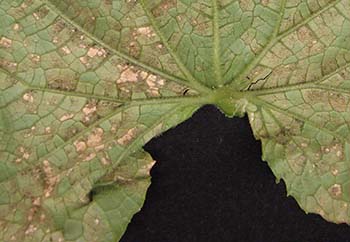Downy mildew recommendations for cucumbers
Use fungicides and new cultivars to manage downy mildew.
Downy mildew causes severe leaf blight on cucurbit crops, including cucumber, melon, squash, and pumpkin (Figure 1). Incited by the fungal-like pathogen Pseudoperonospora cubensis, downy mildew has occurred every growing season for Michigan cucumber growers since 2005.
Although downy mildew can be especially damaging to cucumber and melons, squash and pumpkins may also become infected. The downy mildew pathogen cannot overwinter in Michigan fields but can overwinter in greenhouses or production regions that do not experience a frost. Over the last several years, some fungicides that used to be effective are no longer working well in Michigan. If downy mildew is not effectively controlled, especially early in the cropping cycle, yield loss and misshapen fruit usually occur. Newly released cucumber cultivars with resistance to downy mildew can be helpful but a fungicide program is still required. For Michigan to remain the top producer of pickling cucumbers in the U.S., downy mildew must be controlled.


Figure 1. Left/top, upper side of cucumber leaf infected with downy mildew; note angular lesions with yellowing and dead tissue bound by the leaf veins. Right/bottom, underside of leaf with downy mildew spores appearing as darkened areas. Photos by Mary Hausbeck, MSU.
MSU trial combines fungicide programs and downy mildew resistant cultivars
The four cucumber cultivars included 'Vlaspik,' 'Expedition,' 'Citadel' and 'Peacemaker.' 'Vlaspik' and 'Expedition' are industry standard cultivars that are susceptible to downy mildew. 'Citadel' and 'Peacemaker' became commercially available in 2016 and show an intermediate level of resistance to Michigan’s downy mildew isolates. Each treatment plot was replicated three times and were arranged in a split plot block design, with fungicide treatment program being the main plot and cultivar being the subplot. Fungicides were applied every 7 days and disease was evaluated multiple times. Two harvests were taken and fruit were graded for marketable yield.

Figure 2. Graphs showing, top, AUDPC of disease severity and, bottom, marketable yield of four cultivars of cucumber untreated or treated with three fungicide programs for downy mildew.
The area under the disease progress curve (AUDPC) was calculated and takes into account all disease ratings to provide a season long view of performance. The graphs show the cultivars evaluated across fungicide treatments (Figure 2).
For 'Vlaspik,' 'Expedition' and 'Citadel,' the program of Bravo WeatherStik SC (BWS) alone was better than the unsprayed. When applied to 'Peacemaker,' the Bravo WeatherStik SC alone program was not significantly better than the unsprayed.
Program A, Ranman SC + BWS alternated with Previcur Flex SL + BWS alternated with Zampro SC + BWS, displayed better downy mildew control than the Bravo WeatherStik SC alone program in both the downy mildew susceptible cultivars, but not in the resistant cultivars.
Program B, Orondis Opti SC alternated with Ranman SC + BWS alternated with Previcur Flex SL + BWS, was better than all of the other programs for the susceptible cultivars and 'Citadel,' and provided control similar to Program A (Ranman SC + BWS alternated with Previcur Flex SL + BWS alternated with Zampro SC + BWS).
Unsprayed 'Vlaspik' and 'Expedition' pickles had the lowest total marketable yield when compared with the same cultivars that were sprayed. While 'Vlaspik' pickles were similar in yield regardless of the fungicide program, 'Expedition' pickles responded differently according to the fungicide program. The highest total yield was observed for 'Expedition' pickles treated with Program B (Orondis Opti SC alternated with Ranman SC + BWS alternated with Previcur Flex SL + BWS).
Fungicide Program A, Ranman SC + BWS alternated with Previcur Flex SL + BWS alternated with Zampro SC + BWS, resulted in an intermediate yield level. While treatment with Bravo WeatherStik SC alone resulted in yields better than the unsprayed, the yields were less than those observed from the other fungicide treatments. 'Citadel' showed the highest total yield when treated with Program A (Ranman SC + BWS alternated with Previcur Flex SL + BWS alternated with Zampro SC + BWS). Program B (Orondis Opti SC alternated with Ranman SC + BWS alternated with Previcur Flex SL + BWS) resulted in an intermediate yield level for 'Citadel.'
While the Bravo WeatherStik SC alone program resulted in 'Citadel' yields that were significantly better than the unsprayed, this treatment was not as effective as the other programs when comparing yields. 'Peacemaker' yields did not differ significantly in total yield among the unsprayed and sprayed treatments.
Acknowledgments
This information is based upon work that is partially supported by the Agricultural Research Fund and Pickle and Pepper Research Committee of MSU, Pickle Packers International, Inc.; a Specialty Crop Block Grant administered by the Michigan Vegetable Council; the National Institute of Food and Agriculture, U.S. Department of Agriculture under award number 2016-68004-24931; and Seminis Vegetable Seeds, Inc.
This material is based upon work that is supported by the National Institute of Food and Agriculture, U.S. Department of Agriculture, under award number 2016-68004-24931.



 Print
Print Email
Email

